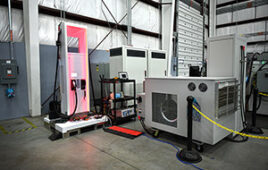
Challenge any modern human to go a day without a phone or computer, and you’d be hard pressed to get any takers. Our collective obsession with all things electronic is driving a dramatic daily drain on the world’s power. In fact, according to studies from the Semiconductor Research Corporation, if we continue on pace with our current ever-increasing energy consumption, by the year 2035, we will use all of the world’s energy to run our computers – an impossible/unsustainable situation.
To combat this looming energy crisis, enter Robert Wolkow. The University of Alberta atomic physicist has devoted his career to developing greener, faster, smaller technology. Research published by his lab this week points to tangible solutions that technology developers can implement now to save society’s power for the next generation.
“Today’s electronics have reached a point of maturation and can’t be made any better. We have to stop using so much electricity to run our computers, and that means we need a drastic change in the kind of computers we use,” said Wolkow, noting that today’s computers can’t run much faster than computers made 10 years ago.
“The atom-scale devices we are developing create a new basis for computer electronics that will be able to run at least 100 times faster or operate at the same speed as today but using 100 times less energy,” continued Wolkow. “We have plotted a path to sustainable, responsible economic growth and green technology that’s good for everyone.”
Extending the silicon road map
Wolkow’s findings, supported by his graduate students and research associates at the University of Alberta and the National Research Council Canada as well as spinoff Quantum Silicon Inc. (QSi), demonstrate not only the option to trade speed and power but also the scalability of binary atomic silicon logic.
“It’s still a familiar binary computer. You can run the same programs. The insides are just a lot better” said Wolkow of his new all silicon device design. “Because our components are made of silicon, we make a straightforward marriage of the new atomic-scale technology with the standard CMOS technology that powers today’s electronics, providing an easy entryway to market.”




